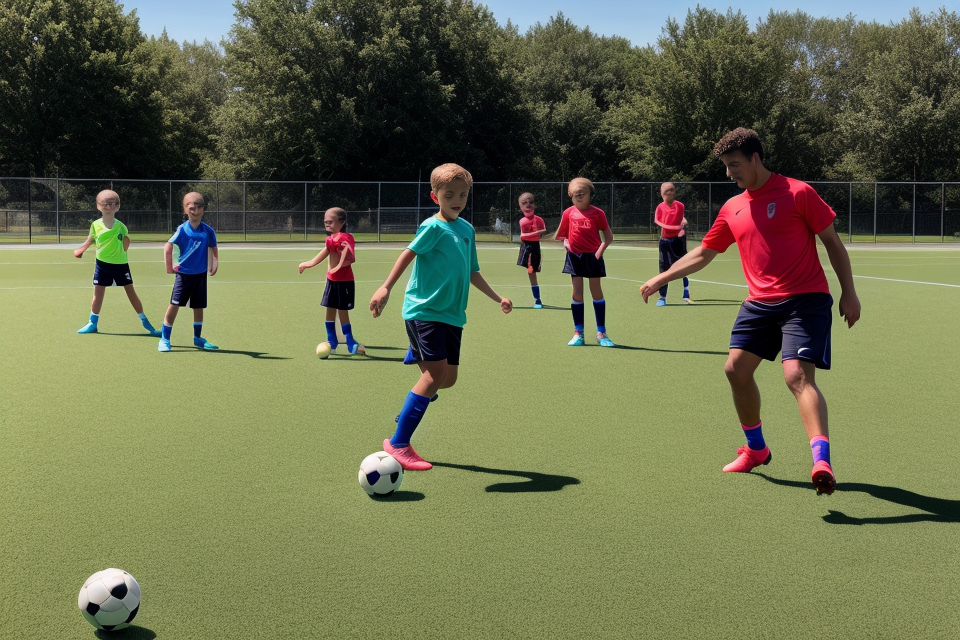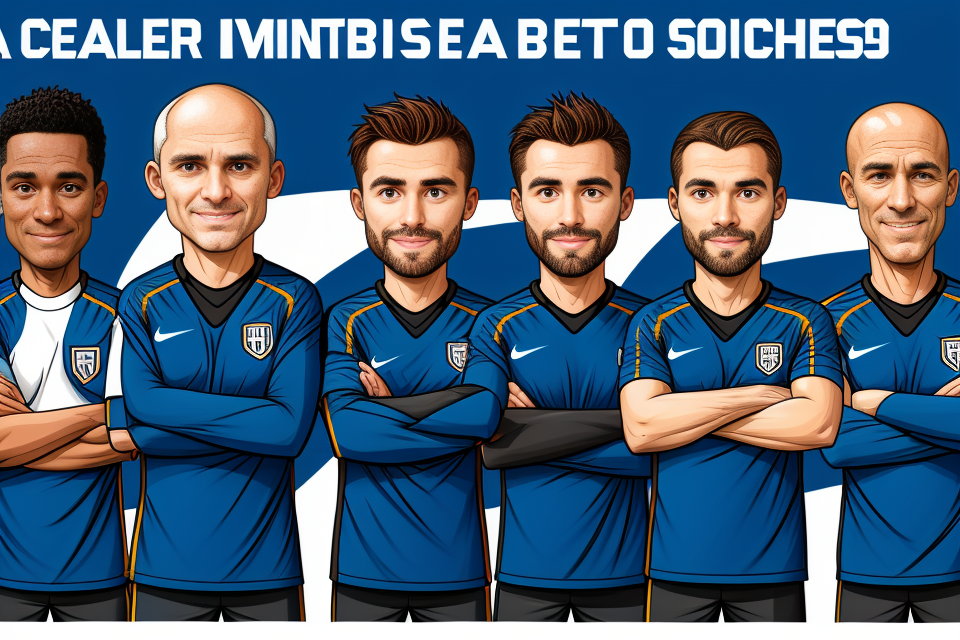Coaching soccer basics is an essential part of developing a successful soccer team. It involves teaching players the fundamental skills they need to excel in the sport, such as dribbling, passing, and shooting. A good coach will focus on mastering these basics to create a strong foundation for the team. This guide will provide a comprehensive overview of how to coach soccer basics, covering topics such as warm-up exercises, drills, and game strategies. By following these guidelines, coaches can help their players develop the skills they need to excel on the field and achieve their goals. Whether you’re a seasoned coach or just starting out, this guide will provide valuable insights and tips to help you coach soccer basics like a pro.
Establishing the Foundations: The Importance of Basic Skills
Understanding the Role of Basic Skills in Soccer
Soccer is a sport that requires a combination of physical abilities, tactical knowledge, and mental fortitude. However, despite the importance of these aspects, it is the basic skills that serve as the foundation upon which the rest of the game is built. By mastering the fundamentals, players can develop the necessary technique, confidence, and ability to perform under pressure.
Developing Technique and Confidence
At the heart of soccer is the ability to control and manipulate the ball. This requires a level of technical proficiency that can only be achieved through the mastery of basic skills. These skills include dribbling, passing, shooting, and receiving. By focusing on these fundamentals, players can develop the necessary technique to control the ball in a variety of situations.
Furthermore, by developing a strong technical foundation, players are also able to build their confidence on the field. When players are confident in their ability to control the ball, they are more likely to take risks and make decisive movements. This, in turn, can lead to more goals and victories for the team.
Building a Strong Foundation for Future Skill Development
Mastering the basics of soccer is not just about developing the skills necessary to perform well in the present. It is also about building a strong foundation for future skill development. As players progress through the ranks, they will encounter increasingly complex tactical situations that require a higher level of technical proficiency. By starting with the basics, players are able to build a solid foundation of skills that they can continue to develop over time.
Enhancing Team Performance
While basic skills are essential for individual performance, they also play a crucial role in enhancing team performance. When all players on a team have a strong foundation in the basics, they are able to work together more effectively. This is because they are able to understand and anticipate the movements of their teammates, leading to better coordination and communication on the field.
Improving Team Cohesion and Communication
Team cohesion and communication are critical factors in the success of any soccer team. When players have a strong foundation in the basics, they are able to understand and anticipate the movements of their teammates. This leads to better communication on the field, as players are able to make split-second decisions based on their understanding of the game.
Fostering a Winning Mindset
Finally, mastering the basics of soccer can help to foster a winning mindset among players. When players have confidence in their ability to control the ball and work together as a team, they are more likely to believe in their own abilities and the abilities of their teammates. This, in turn, can lead to a winning mindset that is essential for success on the field.
Setting the Stage: Preparing for Coaching Soccer Basics
Assessing Player Ability and Determining Training Needs
Conducting Assessments and Evaluations
- Player evaluations: Assess players’ current skills, strengths, and weaknesses to identify areas for improvement.
- Fitness testing: Evaluate players’ physical fitness levels and endurance to ensure they are ready for training.
- Technical assessments: Analyze players’ technical abilities, such as dribbling, passing, and shooting, to determine their proficiency in these areas.
Identifying Strengths and Weaknesses
- Observe players during matches and training sessions to identify their natural strengths and areas where they may need improvement.
- Gather feedback from players, parents, and other coaches to gain a comprehensive understanding of each player’s abilities.
Creating Personalized Training Plans
- Develop individualized training plans for each player based on their strengths, weaknesses, and goals.
- Incorporate age-appropriate drills and exercises that target specific skills and abilities.
Establishing Clear Objectives and Expectations
- Set SMART (Specific, Measurable, Achievable, Relevant, and Time-bound) goals for each player to ensure they are challenging yet attainable.
- Clearly communicate expectations for each player’s behavior, work ethic, and commitment to the team.
Setting SMART Goals
- Specific: Define clear and concise goals that outline what the player needs to achieve.
- Measurable: Establish quantifiable criteria to measure progress and success.
- Achievable: Set goals that are challenging but realistic and attainable within a reasonable timeframe.
- Relevant: Ensure goals align with the player’s long-term development and the team’s objectives.
- Time-bound: Set a deadline for achieving the goals to maintain focus and motivation.
Creating a Positive Learning Environment
- Foster a supportive and positive atmosphere that encourages player growth and development.
- Encourage open communication and provide constructive feedback to help players improve.
- Celebrate successes and recognize individual and team achievements to boost morale and motivation.
Breakin’ it Down: Teaching Soccer Basics
The Art of Effective Demonstration
Choosing the Right Drills and Exercises
- When selecting drills and exercises, it is essential to align them with the specific training objectives. This ensures that the players are working on the skills that need improvement, and the coach can track their progress effectively.
- It is also crucial to incorporate game-like scenarios into the drills and exercises. This helps the players to understand how the skills they are practicing apply in a match situation, making the training more relevant and engaging.
Aligning with Training Objectives
- The coach should identify the specific areas that need improvement and select drills and exercises that target those skills. For example, if the team struggles with passing accuracy, the coach could design drills that focus on passing and receiving.
- By aligning the drills with the training objectives, the coach can ensure that the players are working on the skills that will have the most significant impact on their performance.
Incorporating Game-like Scenarios
- Incorporating game-like scenarios into the drills and exercises helps the players to understand how the skills they are practicing apply in a match situation. This makes the training more relevant and engaging for the players.
- For example, instead of just practicing passing in isolation, the coach could set up a small-sided game that simulates a match situation. This would allow the players to practice passing in a more realistic context, improving their ability to apply the skill in a match.
Mastering the Technique: Key Principles and Techniques
Proper Foot Positioning and Body Alignment
- Proper foot positioning and body alignment are crucial for executing various soccer techniques, such as dribbling, passing, and shooting.
- When demonstrating these techniques, the coach should emphasize the importance of maintaining proper foot positioning and body alignment. This includes demonstrating the correct footwork and body movements required for each technique.
Developing Accurate Passing and Receiving
- Accurate passing and receiving are essential skills in soccer, and mastering them can significantly impact a team’s performance.
- When demonstrating these skills, the coach should focus on the correct footwork and body movements required for accurate passing and receiving. This includes demonstrating how to properly strike the ball and how to position the body to receive the ball accurately.
Enhancing Ball Control and Dribbling
- Ball control and dribbling are crucial skills for any soccer player, and mastering them can help players maintain possession and create scoring opportunities.
- When demonstrating these skills, the coach should focus on the correct footwork and body movements required for effective ball control and dribbling. This includes demonstrating how to properly control the ball while moving and how to change direction while dribbling.
Bridging the Gap: Transitioning from Basics to Advanced Skills
Identifying Opportunities for Skill Progression
As players progress through the various stages of soccer development, it is crucial for coaches to identify opportunities for skill progression that will challenge and stimulate their growth. By carefully selecting appropriate exercises and activities, coaches can create an environment that fosters continuous improvement and encourages players to reach their full potential.
Assessing Player Readiness
Before transitioning to more advanced skills, coaches must assess each player’s readiness to ensure they possess the necessary foundation to succeed. This assessment should take into account a player’s physical abilities, technical skills, and understanding of the game. Coaches should also consider a player’s mental attitude and willingness to learn, as these factors can significantly impact their ability to progress.
Monitoring Progress and Evaluating Performance
To determine a player’s readiness for advanced skills, coaches must closely monitor their progress and evaluate their performance in practice and games. This involves tracking key performance indicators (KPIs) such as passing accuracy, dribbling speed, and shooting precision, as well as observing a player’s decision-making and problem-solving abilities.
Recognizing Signs of Readiness
There are several signs that indicate a player’s readiness to transition to more advanced skills. These include consistently executing basic skills with precision, demonstrating an understanding of tactical concepts, and showing a willingness to take on new challenges. Additionally, players who consistently perform well in practice and display a high level of motivation and engagement are likely ready to progress to more advanced skills.
Facilitating the Transition
Once a player has demonstrated readiness for advanced skills, coaches can facilitate the transition by gradually incorporating these skills into training sessions. This can be achieved by:
Integrating Advanced Skills into Training Sessions
Coaches should gradually introduce advanced skills into training sessions, building on the foundation of basic skills that players have already mastered. This may involve incorporating exercises that challenge players to improve their decision-making, ball control, and situational awareness.
Gradually Increasing Difficulty and Complexity
As players become more proficient in basic skills, coaches should gradually increase the difficulty and complexity of exercises and activities. This can be achieved by introducing new elements, such as opposing teams or changing environmental conditions, that challenge players to adapt and respond effectively.
By carefully identifying opportunities for skill progression and facilitating the transition from basics to advanced skills, coaches can help players achieve their full potential and contribute to the long-term success of their team.
Fostering Growth: Tips for Effective Soccer Coaching
Establishing Open Communication Channels
Encouraging Feedback and Active Listening
Open communication channels are essential for fostering growth in soccer players. By encouraging feedback and active listening, coaches can create a supportive environment that promotes learning and development.
Creating a Supportive Environment
Coaches should create an environment where players feel comfortable sharing their thoughts and opinions. This can be achieved by being approachable, respectful, and understanding. Players should feel that their input is valued and that their opinions matter.
Addressing Concerns and Misconceptions
Coaches should also be willing to address concerns and misconceptions that players may have. This can involve answering questions, providing clarification, and dispelling myths or misconceptions about the game. By doing so, coaches can help players develop a more accurate understanding of the game and their role within it.
Maintaining Motivation and Engagement
Maintaining motivation and engagement is critical for soccer players to reach their full potential. Coaches can foster a positive mindset by promoting a growth mindset, emphasizing effort over outcome, and providing constructive criticism and encouragement.
Fostering a Positive Mindset
Coaches should promote a positive mindset by emphasizing the process of learning and development rather than the outcome of games or matches. This can involve focusing on effort, progress, and growth rather than solely on wins and losses. By doing so, coaches can help players develop a resilient and positive attitude towards the game.
Providing Constructive Criticism and Encouragement
Coaches should provide constructive criticism and encouragement to help players improve their skills and performance. This can involve providing specific feedback, highlighting strengths, and offering suggestions for improvement. Coaches should also be sure to acknowledge and celebrate players’ successes and achievements.
Overall, open communication channels are essential for fostering growth in soccer players. By encouraging feedback and active listening, creating a supportive environment, addressing concerns and misconceptions, maintaining motivation and engagement, and providing constructive criticism and encouragement, coaches can help players reach their full potential and achieve success on the field.
Adapting to Individual Needs and Circumstances
Addressing Physical and Mental Challenges
When coaching soccer, it is essential to consider the unique needs and circumstances of each player. This includes addressing physical and mental challenges that may affect their performance on the field.
Modifying Training Programs for Injuries and Limitations
If a player is injured or has a physical limitation, it is important to modify their training program to accommodate their needs. This may involve reducing the intensity or duration of certain exercises, or modifying specific drills to avoid aggravating the injury.
Supporting Mental Health and Well-being
In addition to physical challenges, coaches must also be aware of the mental health and well-being of their players. This includes providing support and resources for players who may be struggling with anxiety, stress, or other mental health issues.
Nurturing a Winning Attitude
To be successful in soccer, players must have a winning attitude. This includes cultivating resilience and determination, as well as learning how to celebrate success and embrace failure.
Cultivating Resilience and Determination
Resilience and determination are key characteristics of successful soccer players. Coaches can help foster these qualities by encouraging players to persevere through challenges, setting realistic goals, and providing positive feedback and reinforcement.
Celebrating Success and Embracing Failure
Celebrating success and embracing failure are both important aspects of developing a winning attitude in soccer. Coaches can help players learn how to appreciate their accomplishments, while also teaching them how to learn from their mistakes and use failure as a tool for growth and improvement.
The Power of Fundamentals: Building a Strong Soccer Foundation
Long-term Benefits of Emphasizing Soccer Basics
- Developing a strong soccer foundation lays the groundwork for future success. By focusing on the fundamentals, players are better equipped to tackle more advanced techniques and strategies as they progress in their soccer careers.
- Emphasizing soccer basics also cultivates a passion for the game, as players learn to appreciate the sport’s intricacies and develop a sense of accomplishment from mastering essential skills.
Key Takeaways
- Prioritize Fundamentals in Soccer Coaching: Dedicate a significant portion of training sessions to mastering the basics, such as ball control, dribbling, and passing.
- Personalize Training Plans: Tailor training programs to individual players’ needs, focusing on areas where they need improvement or reinforcement.
- Encourage Open Communication and Feedback: Foster an environment where players feel comfortable providing feedback and asking questions, enabling them to learn and grow together as a team.
- Foster a Positive Learning Environment: Create a supportive atmosphere that promotes positive self-talk, encourages risk-taking, and celebrates both successes and learning opportunities.
FAQs
1. What are the essential skills to teach in soccer basics?
The essential skills to teach in soccer basics include ball control, dribbling, passing, shooting, and defense. These skills form the foundation of soccer and are crucial for players to master before moving on to more advanced techniques.
2. How do you teach ball control in soccer?
Ball control can be taught by starting with simple exercises such as ball touches, ball rolling, and ball stopping. Players should learn to control the ball with different parts of their body, including their feet, thighs, and chest. They should also learn to control the ball while in motion, which requires good balance and coordination.
3. What are the best drills for teaching dribbling in soccer?
Dribbling drills should focus on improving a player’s ability to move with the ball while maintaining control. One effective drill is to set up cones in a zig-zag pattern and have the player dribble the ball through the cones using both feet. Another drill is to have the player dribble the ball around a cone and then pass the ball to a teammate.
4. How do you teach passing in soccer?
Passing can be taught by starting with short passes and gradually increasing the distance and complexity of the passes. Players should learn to use different types of passes, including short passes, long passes, and through passes. They should also learn to control the ball before and after the pass, and to communicate with their teammates during the pass.
5. What are the best drills for teaching shooting in soccer?
Shooting drills should focus on improving a player’s accuracy and power. One effective drill is to set up cones or targets and have the player shoot the ball at the targets using both feet. Another drill is to have the player shoot the ball from different distances and angles, including volleys and headers.
6. How do you teach defense in soccer?
Defense can be taught by starting with basic principles such as positioning, marking, and tackling. Players should learn to position themselves correctly and to mark their opponent effectively. They should also learn to tackle the ball properly, using their feet or legs, and to anticipate their opponent’s movements.
7. How important is fitness in soccer?
Fitness is crucial in soccer, as it helps players to perform at their best throughout the game. Players should develop their cardiovascular endurance, strength, and flexibility through regular exercise and conditioning. They should also learn to hydrate properly and to eat a balanced diet to support their physical performance.
8. How can you motivate and encourage young players in soccer?
Young players can be motivated and encouraged by creating a positive and supportive team environment. Coaches should provide feedback and recognition for good performance, and should also encourage players to set goals and work towards them. Players should also be given opportunities to learn and improve, and to experience success on the field.



